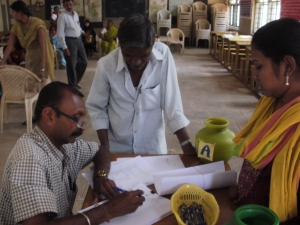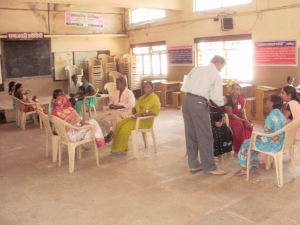Posted by Jean-Pierre Tranchant
As part of our study on violence-prone neighbourhoods described by my IDS colleague Jaideep Gupte [in his recent posts on attrition and tracing households across Maharashtra], we implemented behavioural games in conjunction with the second wave of our household survey. Trust, norms of fairness, or social cooperation are difficult to measure with household surveys, as responses might not relate to actual behaviours in an accurate manner. Experimental games have become a very popular solution to observe complex behaviour without the investment of a long term ethnographic study. [1] A useful game is a game that gives precise and predefined cues to respondents so that they form their decisions as they might in a real-life situation, and allows respondent decisions and behaviour during the game to be recorded for analysis. A good knowledge of the culture under study is then still needed to understand how people will play the game and draw appropriate interpretations. [2]
The main questions we are interested in answering through the games are around the role of social cooperation in conflict: does social cooperation mitigate conflict or is social cooperation a by-product of the absence of the conflict? Alternatively, is there a possibility that social cooperation actually makes conflict more likely? We also wish to shed light on the impact of ethnic, caste and religious heterogeneity on cooperation.
In this post, I would like to share our experience of actually running these games in the field. Most of the literature on experiments is about lab experiments – a highly controlled process where participants (usually graduate students) are seated in front of a computer. Field experiments, on the other hand, are much less controlled, and issues related to the organisation of games can have a large impact on the results.
We had to struggle between the conflicting needs of consistency and flexibility. Running games across 45 sites in 9 districts in a state encompassing over 300,000 sq. km necessitated following strict procedures in order to maintain consistency across the games. Logistical realities, however, called for slack in the system so that we could adapt each game. Some of the questions we faced when implementing the games were – How many games to run? How many participants per game? Where to organise the games? and How to record individual decisions? The following insights come from two pilot sessions organised in Sangli and Kolhapur districts, at the border with the state of Karnataka.
How many games to run?
We had two extreme options here. One was to run one game session in each of our sites. This would have some advantages: it leaves more time for the team to recruit participants, the venue can be chosen to be very close to the site, and the number of participants remains small (our capacity to run games goes down with number of participants). But it involves organising 45 different sessions, thus increasing the cost, and preventing interactions between participants from different sites. At the other end of the spectrum, we could run a single game session in each district, pooling participants from all 5 sites. This would have the reverse virtues (less costly, possibility of inter-neighbourhood/town interactions) and caveats (too many participants, difficulty to recruit because of the distance). We opted for a middle-ground: we organised 2 sessions per district, one with participants from 2 sites together, and the other one with the three remaining sites. Since our sites are usually close to each other (within a city), this could be done without sacrificing proximity to the sites.
How many participants per game?
The protocols we designed were such that it was best to have a fixed number of participants per site, i.e. 6, across all games. In terms of logistics however, it is much easier to allow for some variation around a fixed target, without having to stick to it at all cost. Our team would go to the survey site one day before the games to formally invite 10 people per site (allowing 4 back-up for people not showing up on the day). They were promised 200 rupees for coming, plus the chance of earning more based on the outcome of the exercises (we did not speak of ‘games’ but of ‘exercises’). Importantly, the variable part of the payoff remained undetermined in order not to raise false expectations. Larger groups of participants are always preferable, but with 6 people per site we achieve a sample of 270 participants, producing statistically meaningful results. A higher number of participants would have proved extremely challenging in terms of recruitment, also we would need more cars to ferry participants to and from the venue, the venues themselves would have to be bigger and so on.
The selection procedure was random, i.e. we produced a list of households in each site where the ordering was random but stratified so that households with experience of civil violence were oversampled. Somewhat to the surprise of the team, we did not face much difficulty recruiting enough participants.
We faced more difficulties on the day of the game: our biggest problem was with people arriving late at the venue. We decided to play the games in venues close to the sites, so that some would be able to walk there if they wished so, rather than being dependent on our team’s car. On one occasion we had 17 participants in the venue waiting with increasing restlessness while waiting for the last participant to show up (she came by foot). Sticking to the protocol required us to wait, risking some people walking away. Starting the game with 17 would create an idiosyncratic deviation from the protocol. We decided to distribute tea, which created a respite of 5 minutes, but then came short of strategies. We finally decided to start as it was, and just as things had started, the 18th person walked in…
Where to organise the games?
As I mentioned above, we decided to go for venues close to the sites. A concern of the team was that people from different caste would not want to mix in the same car. Similarly, in more conservative segments of the society, women might not want to enter a car with men. Having venues so close that people could walk there was a way to address such problems. Additionally we chose venues that were neutral (not overtly religious for instance) and not intimidating for our respondents. We ended up using a public library and a marriage hall. Such venues are plentiful in urban India, and quite inexpensive to rent for the day. Even better, there was no need to plan much in advance.
How to record individual decisions?
This is a big question, each individual decision for any given round of any given game must be carefully recorded for later analysis but also for calculating individual payoffs to be distributed at the end of the session. In addition, the context in which players make their decisions is important to ensure anonymity, and lack of pressure. We could not use computers because most of the elder respondents are illiterate and/or unfamiliar with them. Instead we set up two or three ‘decision tables’ in each session staffed by a member of the team. In turn the participants would walk there alone, and from a distance to others make their decision known. We exploited this moment to ask post-decision questions which were useful for later interpretation. The pitfall was the time needed for each participant to walk the table for each decision, thereby slowing down quite a lot the rhythm of the games. At the decision tables we presented the money in front of the players and then asked for their decisions. In retrospect I think it would have been better to hand the money in envelopes to the players, thereby increasing their ownership of their endowment, and make altruistic decisions more costly.
Overall the experience was hugely positive. Importantly, all participants enjoyed their time – and were delighted when they discovered their payoff (average of 730 rupees). The team grew more comfortable at each iteration of the games and as their understanding of the games increased, so their enjoyment in running them. One can think that designing the game would be the most time-consuming part of the process but in fact this was done quickly. Rather, the logistics and the minute organisation of the games (who sits where, who plays first, where to play, etc) took a much bigger chunk of our time. Once we had a strategy in our mind, we ended up spending a lot of time buying stuff like pots, scissors, papers, badges, etc, and printing loads of papers. Working in an urban environment meant that we could do all that on the sites. Our PhD students Alia and Yashodhan, somewhat strained by weeks of fieldwork and painstaking data checking, regained all vitality playing arts and crafts. And seeing actual people playing games you so painstakingly designed was an incredible reward.
[1]Within MICROCON see Voors, M.J., E.E.M. Nillesen, P. Verwimp, E.H. Bulte, B.W. Lensink and D.P. van Soest, 2012. Violent Conflict and Behavior: a Field Experiment in Burundi, American Economic Review, In Press or Lecoutere, E. B. D’Exelle, B. Van Campenhout, 2010. Who Engages in Water Scarcity Conflicts? A Field Experiment with Irrigators in Semi-arid Africa. MICROCON Research Working Papers 31
[2] For an excellent account on how field experiments relate to ethnographic knowledge see the collective book Foundations of Human Sociality: Economic Experiments and Ethnographic Evidence from Fifteen Small-Scale Societies, published in 2004 and edited by Henrich, Boyd, Bowles, Camerer, Fehr and Gintis.




